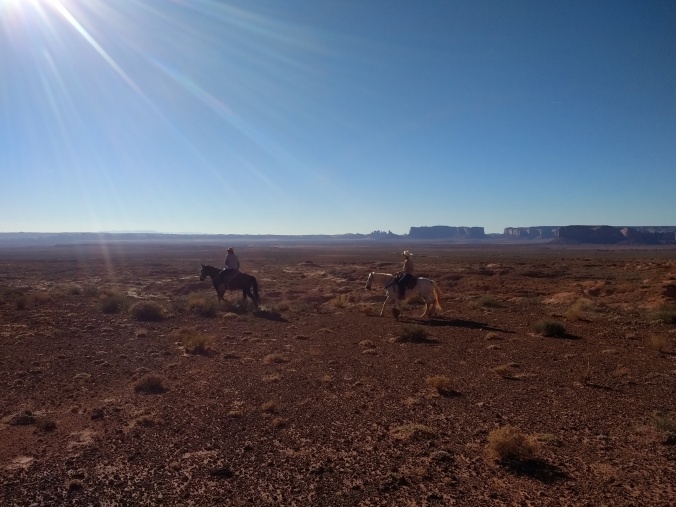It cannot be LD (Limited Distance) because LD’s must be between 25 and 35 miles. But ENDURANCE RIDES must be at least 50 miles. Although the AERC rule book is fairly clear about how to round distances above 50 (to 5 five), and I think we can safely round 47.5 miles up to 50, what about 40 miles? 45?
To those endurance riders distance riders AERC members people who follow the AERC Facebook page, a recent brouhaha about whether certain rides over technically terrain could be counted as endurance even though they were probably less than 50 miles will be familiar… even if only because it caused a flare-up of the endemic Who-is-worthy-of-the-endurance-title-discussion disease.
Yes, on the basis of an obscure duck-ride-debate (have I even got that right? I’m too new to know), someone poked the semantics bear in the AERC Facebook page and a fierce debate ensued between three broad camps:
- Inclusive: People who ride “limited distance” (25 to less than 50 miles) can claim to be endurance riders even though only 50+ mile rides are technically “endurance” rides. It’s all good, it’s all endurance.
- Exclusive (in all meanings of the word): You ain’t an endurance rider if you don’t ride at least 50 miles, and you’d better not claim to be. It’s just a sign of the times that the young ‘uns think 25 miles is something special.
- Waffling: (e.g.) Anybody who rides in AERC riders can call her/himself an endurance rider, but you really haven’t ridden endurance until you’ve completed a 50. People trying to stomp on their elitist tendencies.
I have ridden two 25 mile LD rides on my own mare (pulled in the second due to lameness). I have ridden one 50 mile endurance ride thanks to the generosity of someone else allowing me to ride her mare. I have also volunteered at three rides, including two night rides… I think staying up all night should qualify me as an endurance volunteer at the very least.
All of us who endure the ugly Facebook AERC debates deserve a medal for online-discussion-temper-control endurance.
But I am not sure I have paid my dues so not gonna call myself an “endurance rider.” Yet. I will say that as soon as I have the time and money to get another appropriate horse, I am going to be doing endurance. I’ll start doing it on the first ride and continue doing it until the horse retires. In my mind, the first 5-10 mile training ride counts, and the goal-100 mile endurance ride, hopefully Tevis- will count in even the exclusivists’ minds. The reason I wouldn’t yet call myself an endurance rider is that I personally feel I need more endurance–and by this I mean, training for endurance, whatever the distance–experience and knowledge.
I’ve been thinking about this over the past week, not allowing myself to post on the AERC page or write this blog (because weekdays, workdays, no procrastinating allowed), but now it’s Saturday and I’d like to air some worries and a suggestion.
Worries
It’s bad PR and could discourage participation in any AERC event
This kind of argument (because it’s not really a debate, and it’s not civil enough to be called a discussion) is potentially very damaging to the AERC. Nasty arguments happen with more frequency on the AERC page than on any of the many other equine fora I am a member of.
The same old debates (e.g., barefoot vs steel; when you can safely start a horse… see my funny blogpost) take place place all over the web, not only on Facebook, where there are multiple horse groups, but on places such as Chronicle of the Horse, Horse and Hound, etc. But somehow, these other groups manage to have the same discussions with a lot less acrimony. This is probably in part because endurance riders have a lot of winter downtime and a side effect of riding withdrawal is crankiness, but that’s no excuse.
In other words, AERC page denizens: It’s not necessary to be nasty. We all do it sometimes, but maybe if we all tried, it would happen less often in public.
The thing is, how is AERC going to increase membership (or replace losses with gains) if it presents such an ugly face to the world?
By far the most damaging posts are the elitist “You can’t say you are doing endurance if you don’t ride at least 50 miles” and “in the old days people were tough not like these young LD pansies” ones.
YES this comes off as elitist and snobby and belittling.
If you want to point out that only rides that are at least 50 miles are “endurance rides” as per AERC rule book, find a nicer way to do it.
It could encourage people to ride too far and/or too fast, too soon
One of my favorite sayings: “Any horse can do 25 miles.”
(even my boyfriend has said this to me, and he has cutting horses!! I’d like to see him do an LD!)
And it’s true, if you change it just a little bit: “Any sound horse can do 25 miles if given enough time and ridden appropriately for its condition.
This translates into the simple fact that not everyone can ride a horse in a 25 mile LD ride in the time frame allowed (six hours – hold), at least, not without training for it… unless of course the horse is already in shape in its current job. I know that most of the racehorses I trained could easily have finished 25 miles in under 5 hours with no additional training, but they did 2-4 miles trotting/cantering/galloping plus another 2-3 miles walking under saddle 6 days a week. And that’s not counting the hours of hand-walking. A working ranch horse could probably do it too. But most people do not have racehorses in training or working ranch horses.
Still, it is true that most sound horses could do a 25-mile LD within the time frame, if properly conditioned and ridden. And that’s a great thing! I love it when experienced riders encourage newbies on the AERC page by telling them to use the horse they have and love, at least at the beginning.
Unfortunately the “any horse can do 25 miles” is often used in the context of “and therefore 25 miles is no biggie and most definitely not endurance so please don’t put it in the same bucket as ENDURANCE rides.”
What I worry more about is that some people might be inclined to do a 50 before their horses are ready just so they can join the club. Fortunately most people pay more attention to the precepts behind AERC–caring for your horse, finishing fit to continue, yes, to finish is to win–than to the allure of being part of the exclusive endurance club.
Seriously, what does happen to rides that fall between 37. 5 (assuming we can round down to 35) and 47.5 miles?
Given the rules, this means no rides can be (approximately) 40 or 45 miles.
Now, if land and its use (and ride manager time) were unlimited, this really wouldn’t be an issue. I can see the rationale behind a gap dividing limited distance and full rides, and there really isn’t a meaningful training difference between 35 & 40 and 45 & 50.
But if we are going to be picky about distance precision–something we now have the ability to do–then perhaps we ought to give ride managers more flexibility in distance and course design.
What then do we do with the 40-45 miles rides?
Middle distance? Inconvenient-course-measurement-distance? Almost-endurance?
If it weren’t so much work, there could be a new scoring system that handicaps according to difficulty (some equation of distance, climate, and technicality that handicaps for extreme weather conditions and difficult terrain). Because there is no doubt in my (admittedly endurance-novice) mind that it is not the same to ride 50 miles on smooth, flat terrain as it is to ride 50 miles through rocks and/or mud or with thousands of feet of elevation change. (I compare riding in my native Sierra Nevada to riding in my current home state of mostly-flat Oklahoma). Or 50 miles in a dry climate to 50 miles in extreme humidity (again, foothills of the Sierra Nevada to Oklahoma, and those really aren’t the greatest extremes even in this country).
I don’t know, and I wouldn’t care, whether 40 miles would need to be limited distance or “endurance” or something in between. But then, I don’t have the weight of history-with-endurance on my shoulders and opinions. I do think that the more flexibility ride managers have, the better.
A Suggestion:
On page 11 of the 2017 AERC rule book (I don’t know where my more recent rule book is, but it’s probably the same page; it’s page five in the online book), in the section devoted to Junior Riders (which may need revision at some point, but that’s another topic), the first sentence reads:
“10. All Junior riders in both full and Limited Distance rides….”
This sentence suggests to me a nice solution to the LD vs endurance non-issue:
Why not call EVERY AERC-sanctioned ride endurance and distinguish between “full” and “limited distance” rides? There could be a “middle distance” category for 40-45 mile rides (or they could be subsumed into LD or Full, or prohibited, though I believe that would be foolish).
For some people and horses, 25-35 miles may qualify as true endurance because of the physical limitations (or training time constraints, or whatever) they bring to the endeavor. For those for whom 35 miles is a walk in the park, well, maybe we need a more august name than “full.” All sorts of, erm, amusing, options are occurring to me (The Real Deal; Heritage–maybe this needs more qualifiers–; Original… ok stopping now). Others may have much more appropriate ideas.
And others may hate the entire proposal, but that’s okay, feel free to comment.
& Pictures galore!
Because I got lots and lots of great pictures on the AERC page, I will put all of them below (the ones I haven’t already used above). Many people riding many different types of horses in different distances, different terrains, different states, countries, continents. All enjoying their horses.
Thanks to everyone who contributed a photo, I’ve captioned with the information you gave me, and included all watermarks.
And even more pictures, added June 18:
June 19:

Photo credit Trinity Nelzen
Resources:
Go the Distance: The Complete Resource for Endurance Horses
Endurance 101: a gentle guide to the sport of long-distance riding












































